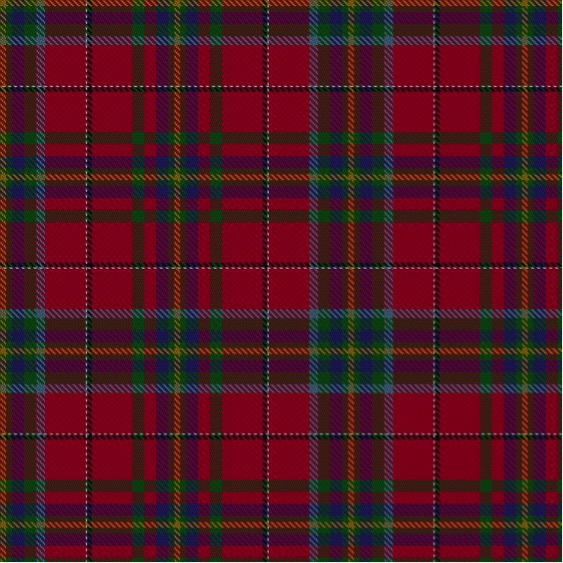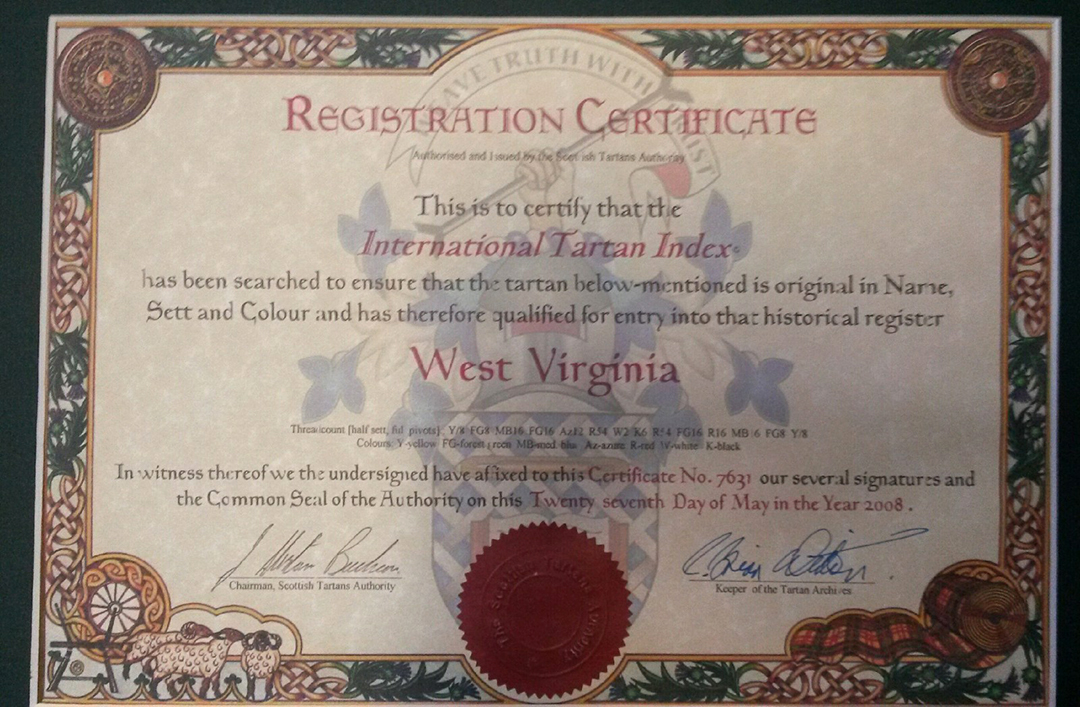Official West Virginia State Tartan. Photo by John A. Grant III (all rights reserved, used by permission). All state tartans.
Official State Tartan of West Virginia
West Virginia adopted an official state tartan in 2008. All State Tartans
The colors of the West Virginia State Tartan were chosen to represent the mountain state's history, culture and beauty:
What is a Tartan?
Tartan is defined as a cloth with a twill weave, usually made of wool, using a unique pattern of multicolored stripes in both directions, and accepted by some group as "theirs." Tartans represent clans (families) or regions in Scotland. In old Scotland, the tartan was used for clothing. Because a family or community worked the cloth together, their clothing was made of the same patterns. In the eighteenth century Clan Tartans were adopted and a person could be recognized by the tartan they wore. Tartans can also be designed as a symbol to commemorate a special event or person.
A tartan pattern is traditionally called a "sett." When woven, the sett is mirrored in all directions and defined by a particular thread count. The sett for the West Virginia State Tartan:
Sett Thread Count, Pivots Full: Dark Yellow 4, Forest Green 4, Muted Blue 8, Forest Green 4, Azure 6, Scarlet 24, White 2, Black 6, Scarlet 24, Forest Green 8, Scarlet 8, Muted Blue 8, Forest Green 4, Dark Yellow 4 and reverses.
History of the Official West Virginia State Tartan
The quest for an official state tartan for West Virginia began at Stone Mountain, Georgia in 2005 when John A. Grant III, a native West Virginian of Scottish descent, asked his good friend Phillip D. Smith PhD, "Why doesn't West Virginia have a state tartan like so many other states?" His reply to John was, "Why don't you design one?" And so, with Dr. Smith's guidance, John began the task of composing a tartan to include symbols of his native state. After several attempts, the West Virgina State Tartan was born.
In January 2008, Kevin and Ron (John’s brothers), began a campaign with West Virginia delegates Fragale, Cann, Laquinta, and Miley to establish an official West Virginia state tartan. In February 2008, House Concurrent Resolution #29 was introduced and passed in the House and on March 6, 2008, it was passed in the Senate.
On May 3, 2008, the first weave of official West Virginia tartan was unveiled by the Grant family at the Scottish Festival and Celtic Gathering in Bridgeport, West Virginia. This first weave is now housed at the West Virginia Division of Culture and History Museum in Charleston, West Virginia. On May 27, 2008, the Official West Virginia State Tartan was recognized by The Scottish Register of Tartans and given the official reference number of 7631.
On March 10, 2009, the first products, woven in Scotland by Ingles-Buchan, reached American soil and on April 6, 2009, National Tartan Day, John, Ron, and Kevin presented an Official West Virginia Tartan tie and scarf to then Governor Joseph Manchin.
House Concurrent Resolution No. 29
By Delegates Fragale, Cann, Laquinta, and Miley
Designating an adaptation of “West Virginia Shawl” as the Official Tartan of the State of West Virginia.
WHEREAS, Several states have recognized their Celtic links, by establishing official state tartans; and
WHEREAS, A majority of West Virginia's early settlers were descendants of Celtic people, who came from their native lands, to find freedom and adventure in the new world; and
WHEREAS, These settlers were the pioneers who helped carve this nation out of the wilderness; and
WHEREAS, Dr. Philip D. Smith, who is not only an accomplished author, professor and recognized world authority on Celtic history and tartan discovered an unknown shawl at the Barboursville “Daughters of the American Revolution Museum”; and
WHEREAS, He named this shawl in his book entitled “Book of Tartans” as the West Virginia Shawl; and
WHEREAS, The adaptation of the “West Virginia Shawl” includes the colors which most fully represent our states history, culture and beauty; and
WHEREAS, The Official West Virginia State Tartan shall be a symmetrical design starting at the dark yellow pivot point and containing the thread count as follows: Dark yellow 4, forest green 4, muted blue 8, forest green 4, azure 6, scarlet 24, white 1, black 6, scarlet 24, forest green 8, scarlet 8, muted blue 8, forest green 4, dark yellow 4; and
WHEREAS, In order to complement our mountain state the color red is to represent the cardinal; yellow for the fall colors; dark blue for the mountain rivers and lakes; black for the black bear, coal and oil; green for the rhododendron and mountain meadows; azure for the sky above; and white to have all the colors of this great nation intertwined with the State of West Virginia; therefore, be it
Resolved by the Legislature of West Virginia: That the adaptation, as described above, of the “West Virginia Shawl” be designated the Official Tartan of the State of West Virginia; and, be it
Further Resolved, That the Clerk of the House of Delegates forward a certified copy of this resolution to Dr. Philip D. Smith, J. Kevin Grant, Ronald E. Grant and John A. Grant III.
CONTRIBUTORS: Content for this article was submitted by Kevin Grant and John A. Grant III / Official Site of the West Virginia Tartan

